HTC One S Review - International and T-Mobile
by Brian Klug on July 17, 2012 9:30 AM ESTWe’ve already seen 1.5 GHz dual core Krait (MSM8960/MSM8260A/MSM8660A) performance before and talked about it in the HTC One X (AT&T) review, and the USA SGS3 review. For the most part, what we see with the HTC One S variants is largely the same as what we saw with a number of other dual core Krait based devices. Recall that MSM8960, MSM8660A, and MSM8260A differ only in baseband and thus what air interfaces are supported. The only big difference between the devices we've seen based on that SoC so far is RAM, and again the HTC One S includes 1 GB of LPDDR2.
If you’re looking for a detailed comparison to the International SGS3 with Exynos 4412, I've finally had a chance to play with one and we will be doing a more direct comparison with Tegra 3, Exynos 4412, and dual core Krait shortly. I've tossed in the numbers from the International SGS3 for comparison already.
For now, however, let's talk about the HTC One S.
JavaScript Performance
Measuring JavaScript performance is just one component of overall web browsing performance, but it’s the most mature in terms of something we can benchmark. Sunspider 0.9.1 is quite possibly the most well known of these JavaScript tests, and a regular staple of our testing suite:
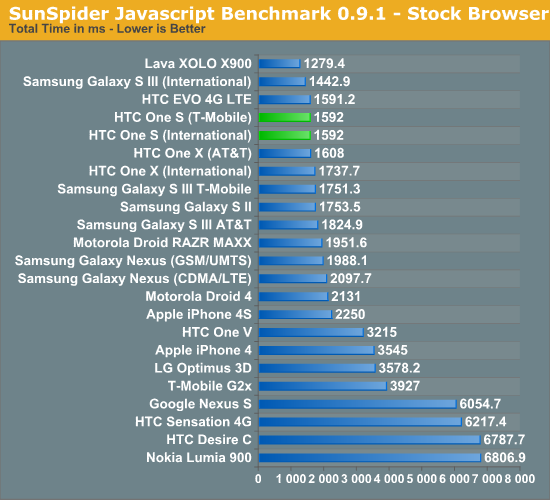
There's an obvious grouping of 1.5 GHz dual core Krait devices around 1500 ms. What spread there is between devices is primarily a function of whatever tweaks OEMs have made to the stock browser's V8 JavaScript engine.
Next up is Browsermark, which is another primarily JavaScript benchmark, with a few other measures. I'm told there are future versions planned which target HTML5 canvas performance.
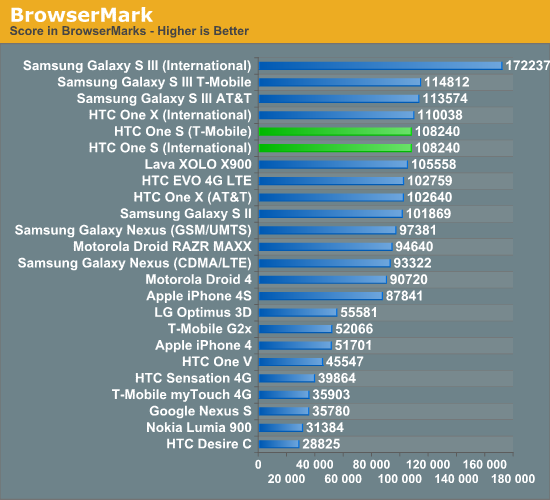
Again there's an obvious clump of dual core Krait devices. The International SGS3 pulls way ahead here for some reason.
Next up is Vellamo, which is a Qualcomm benchmark developed originally for OEMs to use and optimize their browser performance with, and later released for general use. It’s a regular member of our test suite and includes both JavaScript tests and scrolling tests that stress the display composition and hardware acceleration in an Android WebView.

Unsurprisingly the Qualcomm based devices do well in their own benchmark. All of the devices that score above 2000 feel very smooth browsing around in the stock browser and WebView. For the most part, choppy translation and zoom is a thing of the past on Android 4.x.
Low Level FP Performance
Linpack isn’t a great indication of overall smartphone performance, but it is a good test of the floating point capabilities of the CPUs in these SoCs. ARM has steadily been improving FP performance for the past few generations but we’re going to see a big jump to Krait/A15. As most client smartphone workloads are integer based and those that are FP heavy end up relying on the GPU, an advantage here doesn’t tell us much today (particularly because Linpack isn’t running native code but rather atop Dalvik) other than how speedy the FPUs are. There’s a new port of Linpack which runs using native code which we’ll be trying out in the big performance comparison piece.
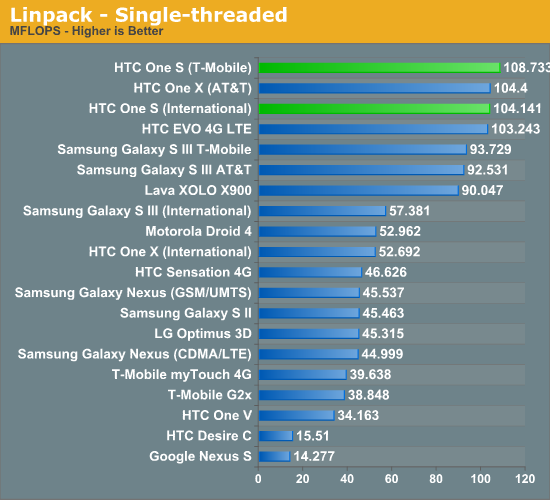
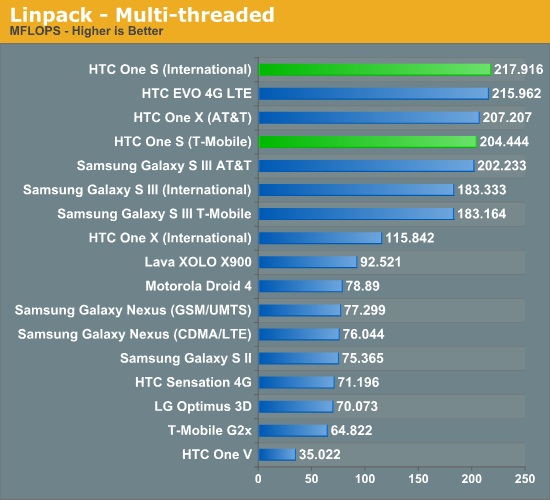
I'm becoming more and more dissatisfied with this GreeneComputing build of Linpack, and given the availability of some alternatives which are implemented natively as opposed to atop Dalvik, will probably move away from it very soon.
BaseMark OS
Rightware’s BaseMark OS is a general purpose benchmark designed to better simulate overall Android performance. It includes a heavily threaded benchmark, file IO tests, and compression/decompression tasks that all contribute to its overall score. This benchmark is pretty much the closest thing we have to a system benchmark for Android at this point, and is very close to achieving the same level of adoption that a few other big industry benchmarks have.
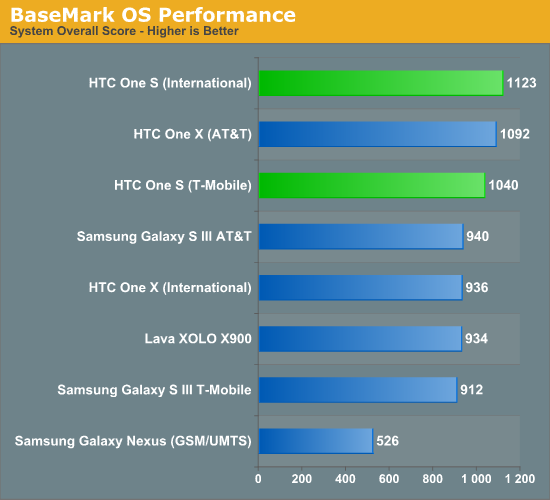
GPU Performance - GLBenchmark 2.1
As we wait for actual 3D gaming benchmarks to make their way into Android (and hopefully cross platform) games, we must rely on synthetic tests designed to simulate 3D game performance as best as possible. We start with GLBenchmark, one of the better Android GPU tests on the market today. There are two benchmarks, Egypt and Pro, and each is run in two modes: native screen resolution and offscreen (vsync disabled) at 720p. The latter is more useful for apples to apples comparisons as everything is rendering the same number of pixels, whereas performance in the onscreen tests is determined by the screen resolution of the device along with the performance of its GPU.
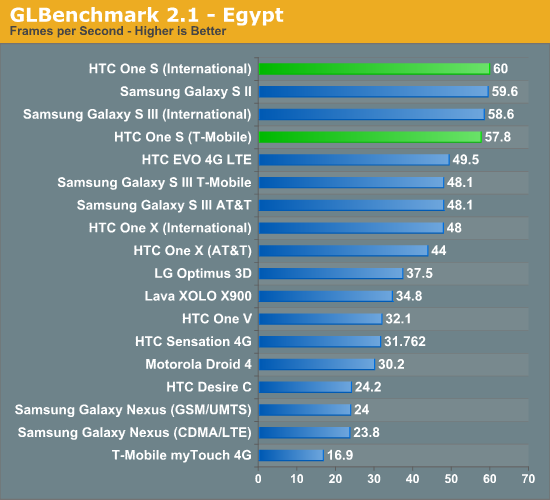

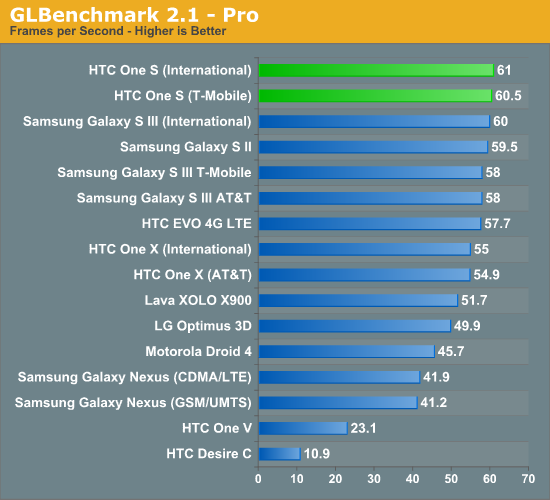
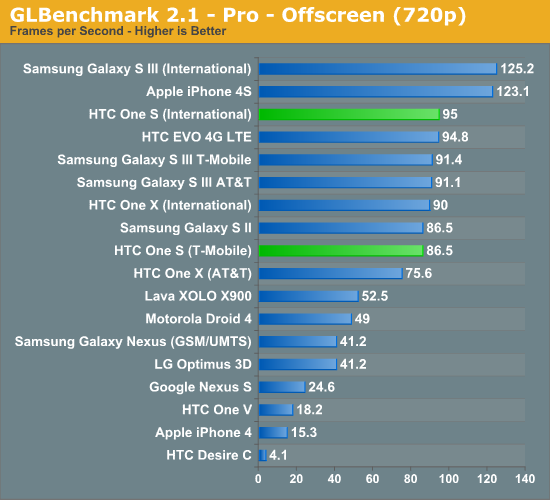
As a reminder, only the offscreen tests take place with vsync turned off, which is why you see devices with 720p displays posting different results on versus off screen where vsync is off. Part of the deal in getting Krait to market as quickly as possible required that Qualcomm pair the CPU with an older GPU, in this case the Adreno 225 instead of the newer Adreno 3xx offerings due out later this year in SoCs like MSM8960 Pro or the quad core Krait APQ8064. As a result, you can see the SGS2 with Exynos 4210 and the SGX543MP2 in the iPhone 4S pull ahead in some tests. Obviously the on-screen test isn’t a totally fair comparison because of the inherent difference in resolution - the One S is qHD.
Basemark ES 2.0 V1
Rightware’s Basemark ES 2.0 V1 is an aging GPU test that tends to favor Qualcomm’s Adreno GPUs above almost all others:
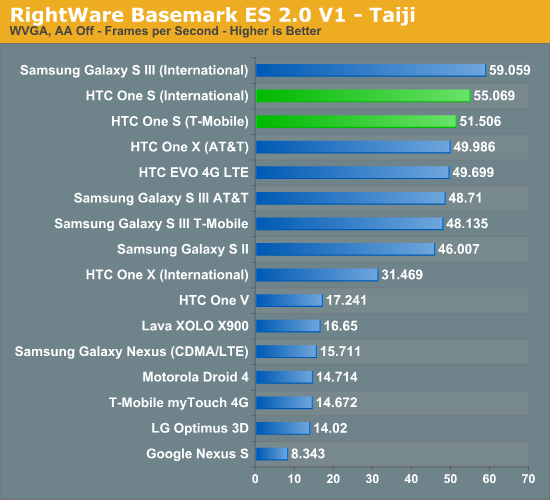
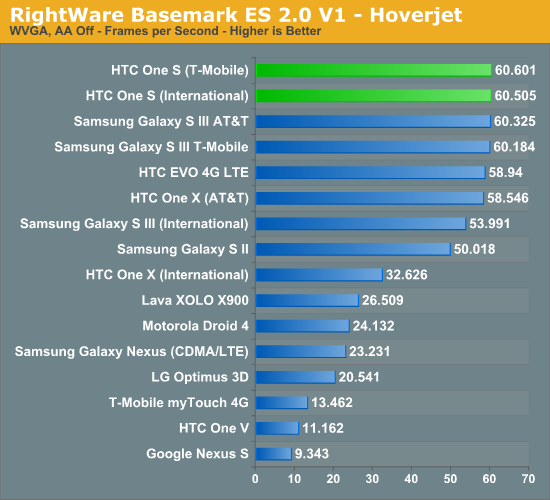
These two tests we run at WVGA on the device. Basemark ES 2.0 is definitely starting to show its age, as Hoverjet is at vsync essentially the whole time, and Taiji is nearly there as well. Qualcomm appears to be using ES 2.0 as an optimization target, so I wouldn’t put too much faith in the ES 2.0 results.










97 Comments
View All Comments
flashbacck - Wednesday, July 18, 2012 - link
I have a T-mobile One S. I've noticed (and would be interested in hearing what other people have experienced) that battery life is destroyed if you turn on the "best wi-fi performance" setting in the wi-fi > menu > advanced menu.Zoomer - Thursday, July 19, 2012 - link
That should be the settings that leaves wifi on all the time (disables sleep). That would destroy battery life for any device.Death666Angel - Thursday, July 19, 2012 - link
My SGS2 runs with that I always get comfortably through a day of medium to heavy use. Since my 2000mAh battery upgrade, I could maybe approach 2 days but why bother? :Ddxkj - Wednesday, July 18, 2012 - link
It pulls ahead for "some reason". I believe that reason is the quad core is on the international version and the 2 core is on the US versionsunsetsam - Friday, July 27, 2012 - link
Article says "sealed battery", chart shows "Removable". Pretty sure it's sealed, and if so, that's a deal killer. Really like my Sensation and was looking to upgrade, but sealed battery, no deal.Tomsgate - Monday, September 10, 2012 - link
Generally a nice device, but be aware that many times many users, including myself, are experiencing a SERIOUS ISSUE whenever carrier signal is weak: The capacitive Home Touch Button then tends to press itself. When in an app or on the home screen with or without the finger near the home button it seems to spaz out as if the home button gets pressed in quick time succession.Basically, you then completely loose control over your phone. Just google "HTC one S touch home button issue" and you'll see plenty of posts and videos about it.
This issue has been reported to HTC by many users for several months now, but no patch or update has been released now as to address the problem. So keep this in mind if you want to purchase this device... You have been warned.
HTC, please take position and FIX THIS ISSUE! Thank you...
Other issues on this phone (personal experience):
- HTC Task widget duplicates tasks by itself, up to X times
- Connectivity issues, phone suddenly switches between 3G and HSPDA permanently, resulting in extremely slow data connection
- Sync issues with contacts (ICS issue)
Reported issues:
- Black metal coating chipping off on black edition
Karl1 - Thursday, September 13, 2012 - link
HOME SCREEN BUTTON ISSUE!In many ways this phone is excellent, but it has a huge design flaw and becomes almost useless in areas with poor reception.
No point describing it in detail here, just google 'home screen button issue'. There are hundreds of people reporting the problem and receiving precisely zero support from HTC.
Obviously not every handset seems to be affected, but I have had two that were (replaced the first one), and the spreadsheet listing those affected is growing daily. Worse, the problem seems to take a few weeks to develop (so you will be outside your cooling-off period and will not be able to return it), then becomes increasingly bad after that.
Seriously, think twice before buying this phone. If I knew what I know now I would not even consider it. I certainly will never buy an HTC again.